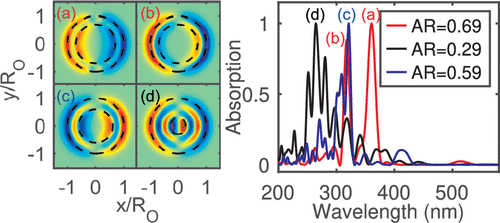当前位置:
X-MOL 学术
›
J. Phys. Chem. C
›
论文详情
Our official English website, www.x-mol.net, welcomes your
feedback! (Note: you will need to create a separate account there.)
Plasmonic Properties of Metallic Nanoshells in the Quantum Limit: From Single Particle Excitations to Plasmons
The Journal of Physical Chemistry C ( IF 3.3 ) Pub Date : 2020-12-03 , DOI: 10.1021/acs.jpcc.0c10507 Tharaka Perera 1 , Sarath D. Gunapala 2 , Mark I. Stockman 3 , Malin Premaratne 1
The Journal of Physical Chemistry C ( IF 3.3 ) Pub Date : 2020-12-03 , DOI: 10.1021/acs.jpcc.0c10507 Tharaka Perera 1 , Sarath D. Gunapala 2 , Mark I. Stockman 3 , Malin Premaratne 1
Affiliation

|
Plasmonic nanoshells show great promise in a wide range of quantum applications due to the tunability of the plasmon frequency across a broad spectral range. With the aim of giving a clear detailed analysis of the onset of plasmon generation and subsequent sustenance of plasmons on nanoshells in the quantum limit, we provide a fully quantum mechanical description of nanoshells using real-time and real-space time-dependent density functional theory. On the basis of the aspect ratio (AR), we identify three types of nanoshells; thin (AR ≥ 0.6), medium (0.35 ≤ AR < 0.6), and thick (AR < 0.35), each showing different types of plasmon modes. Small nanoshells with a thin metallic layer show symmetrically or antisymmetrically coupled plasmons, which agree with semiclassical predictions. However, in nanoshells with medium and thick metallic layers, we identify two types of quantum core plasmons modes, each mixing with symmetrically or antisymmetrically coupled plasmons. For semiclassical modes, all of the electron transitions; monotonic and oscillatory, are near the Fermi level, whereas for quantum core plasmon modes, electrons tend to transition to higher energy levels. We also discuss the dependency of optical properties on aspect ratio, overall size, ground-state electron density profile, spillout, material, and symmetry of nanoshells.
中文翻译:

量子极限内的金属纳米壳的等离子特性:从单粒子激发到等离子。
由于等离子激元频率在很宽的光谱范围内具有可调谐性,因此等离激元纳米壳在广泛的量子应用中显示出广阔的前景。为了清晰地分析等离激元的发生以及在量子极限内等离激子在纳米壳上的维持,我们使用实时和时空依赖于密度的泛函理论提供了对纳米壳的完整量子力学描述。 。根据长宽比(AR),我们确定了三种类型的纳米壳。薄(AR≥0.6),中(0.35≤AR <0.6)和厚(AR <0.35),每种都显示不同类型的等离子体激元模式。具有薄金属层的小纳米壳显示出对称或反对称耦合的等离激元,这与半经典预测相符。但是,在具有中等和较厚金属层的纳米壳中,我们确定了两种类型的量子核等离子体激元模式,每种模式都与对称或反对称耦合的等离子体激元混合。对于半经典模式,所有电子跃迁;单调的和振荡的,接近费米能级,而对于量子核等离激元模式,电子倾向于过渡到更高的能级。我们还将讨论光学特性对长宽比,整体尺寸,基态电子密度分布,溢出,材料和纳米壳对称性的依赖性。
更新日期:2020-12-17
中文翻译:

量子极限内的金属纳米壳的等离子特性:从单粒子激发到等离子。
由于等离子激元频率在很宽的光谱范围内具有可调谐性,因此等离激元纳米壳在广泛的量子应用中显示出广阔的前景。为了清晰地分析等离激元的发生以及在量子极限内等离激子在纳米壳上的维持,我们使用实时和时空依赖于密度的泛函理论提供了对纳米壳的完整量子力学描述。 。根据长宽比(AR),我们确定了三种类型的纳米壳。薄(AR≥0.6),中(0.35≤AR <0.6)和厚(AR <0.35),每种都显示不同类型的等离子体激元模式。具有薄金属层的小纳米壳显示出对称或反对称耦合的等离激元,这与半经典预测相符。但是,在具有中等和较厚金属层的纳米壳中,我们确定了两种类型的量子核等离子体激元模式,每种模式都与对称或反对称耦合的等离子体激元混合。对于半经典模式,所有电子跃迁;单调的和振荡的,接近费米能级,而对于量子核等离激元模式,电子倾向于过渡到更高的能级。我们还将讨论光学特性对长宽比,整体尺寸,基态电子密度分布,溢出,材料和纳米壳对称性的依赖性。











































 京公网安备 11010802027423号
京公网安备 11010802027423号